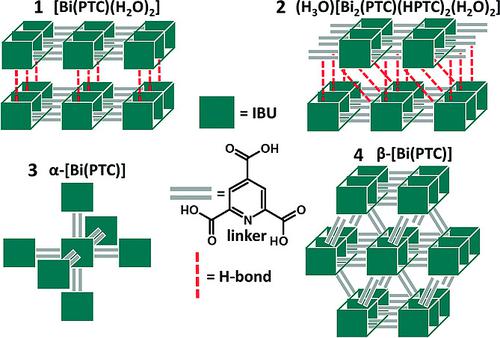当前位置:
X-MOL 学术
›
Eur. J. Inorg. Chem.
›
论文详情
Our official English website, www.x-mol.net, welcomes your feedback! (Note: you will need to create a separate account there.)
Bismuth Coordination Polymers with 2,4,6‐Pyridine Tricarboxylic Acid: High‐Throughput Investigations, Crystal Structures and Luminescence Properties
European Journal of Inorganic Chemistry ( IF 2.3 ) Pub Date : 2018-07-12 , DOI: 10.1002/ejic.201800154 Timo Rhauderwiek 1 , César dos Santos Cunha 1, 2 , Huayna Terraschke 1 , Norbert Stock 1
European Journal of Inorganic Chemistry ( IF 2.3 ) Pub Date : 2018-07-12 , DOI: 10.1002/ejic.201800154 Timo Rhauderwiek 1 , César dos Santos Cunha 1, 2 , Huayna Terraschke 1 , Norbert Stock 1
Affiliation

|
Four new coordination polymers (CPs) were obtained under hydrothermal reaction conditions using 2,4,6‐pyridinetricarboxylic acid (H3PTC) and Bi(NO3)3·5H2O. The systematic high‐throughput investigation of the system Bi3+/H3PTC/NaOH/HNO3/H2O led to the compounds [Bi(PTC)(H2O)2] (1), (H3O)[Bi2(PTC)(HPTC)2(H2O)2] (2), α‐[Bi(PTC)] (3) and β‐[Bi(PTC)] (4), which were structurally characterised by single‐crystal X‐ray diffraction. Compounds 1 and 2 crystallise in 2D layered structures, whereas 3 and 4 form 3D coordination networks. Employing the nomenclature proposed by Cheetham et al. 1 and 2 are classified as I1O1 (mixed inorganic–organic layers), 3 as I0O3 (3D coordination polymers) and 4 as I1O2 (mixed inorganic–organic 3D framework). In all cases the nitrogen atom of the linker is coordinated to the Bi3+ ion, which therefore acts as a tridentate pincer‐type ligand. All title compounds were obtained as phase‐pure products employing conventional or microwave‐assisted heating, but the reproducibility of the synthesis depends on reactor size and material. In addition, the luminescence properties of 1 and 2 were studied resulting in a yellow and blue–green luminescence under UV light with emission maxima at 570 nm (λex = 343 nm) and 483 nm (λex = 347 nm) for 1 and 2, respectively. The differences in the spectroscopic properties could be assigned to the distinct coordination and chemical environments of the Bi3+ ions within these compounds.
中文翻译:

具有2,4,6-吡啶三羧酸的铋配位聚合物:高通量研究,晶体结构和发光性能
使用2,4,6-吡啶三甲酸(H 3 PTC)和Bi(NO 3)3 · 5H 2 O在水热反应条件下获得了四种新的配位聚合物(CPs)。系统Bi 3的系统高通量研究+ / H 3 PTC / NaOH / HNO 3 / H 2 O生成化合物[Bi(PTC)(H 2 O)2 ](1),(H 3 O)[Bi 2(PTC)(HPTC)2( H 2 O)2 ](2),α‐ [Bi(PTC)](3)和β‐ [Bi(PTC)](4),通过单晶X射线衍射对其结构进行了表征。化合物1和2以2D分层结构结晶,而化合物3和4形成3D配位网络。采用Cheetham等人提出的命名法。1和2被归为我1 Ô 1(混合无机的有机层),3为我0 ö 3(3D配位聚合物)和4作为我1 ö 2(混合无机-有机3D框架)。在所有情况下,连接基的氮原子均与Bi 3+配位离子,因此充当三齿钳型配体。所有标题化合物都是采用常规加热或微波辅助加热制成的纯相产品,但合成的重现性取决于反应器的大小和材料。另外,发光特性1和2进行了研究,导致在UV光下的黄色和蓝绿色的发光与发射最大值在570nm(λ EX = 343纳米)和483纳米(λ EX = 347纳米)为1和2,分别。光谱性质的差异可归因于Bi 3+的独特配位和化学环境 这些化合物中的离子。
更新日期:2018-07-12
中文翻译:

具有2,4,6-吡啶三羧酸的铋配位聚合物:高通量研究,晶体结构和发光性能
使用2,4,6-吡啶三甲酸(H 3 PTC)和Bi(NO 3)3 · 5H 2 O在水热反应条件下获得了四种新的配位聚合物(CPs)。系统Bi 3的系统高通量研究+ / H 3 PTC / NaOH / HNO 3 / H 2 O生成化合物[Bi(PTC)(H 2 O)2 ](1),(H 3 O)[Bi 2(PTC)(HPTC)2( H 2 O)2 ](2),α‐ [Bi(PTC)](3)和β‐ [Bi(PTC)](4),通过单晶X射线衍射对其结构进行了表征。化合物1和2以2D分层结构结晶,而化合物3和4形成3D配位网络。采用Cheetham等人提出的命名法。1和2被归为我1 Ô 1(混合无机的有机层),3为我0 ö 3(3D配位聚合物)和4作为我1 ö 2(混合无机-有机3D框架)。在所有情况下,连接基的氮原子均与Bi 3+配位离子,因此充当三齿钳型配体。所有标题化合物都是采用常规加热或微波辅助加热制成的纯相产品,但合成的重现性取决于反应器的大小和材料。另外,发光特性1和2进行了研究,导致在UV光下的黄色和蓝绿色的发光与发射最大值在570nm(λ EX = 343纳米)和483纳米(λ EX = 347纳米)为1和2,分别。光谱性质的差异可归因于Bi 3+的独特配位和化学环境 这些化合物中的离子。



























 京公网安备 11010802027423号
京公网安备 11010802027423号